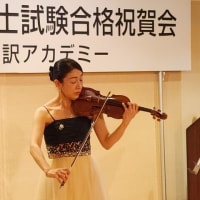さ第2次口述試験の出典(種本)のご紹介
━━━━━━━━━━━━━━━━━━━━━━━
4冊の出典(種本)
━━━━━━━━━━━━━━━━━━━━━━━
近年の第2次口述試験の問題(プレゼン、外国語訳)には、主に有力な4冊の出典(種本)があり、それらの本から繰り返し出題されているという事実があります。受験者としては、事前に有力な出典(種本)を勉強しておくことは、受験対策上、極めて有利なことです。
・2016年度【11:00~12:00】(通訳問題)鳥居(歴史・伝統文化)(P.191)
・2018年度【13:00~14:00】(外国語訳)ラーメン(食事・料理)(P.69)
・2019年度
【13:00~14:00】(外国語訳)桜前線(自然・地理)(P.44)、
【14:00~15:00】(外国語訳)寿司(B)(食事・料理)(P.62)
【14:00~15:00】(外国語訳)おせち料理(年中行事・社会生活)(P.124)
【15:30~16:30】(外国語訳)花火(年中行事・社会生活)(P.143)
・絶版にて入手できません。(残念!)
【2】「英語で説明する日本の文化」(語研)の出典ページと目次
http://www.hello.ac/nihonnobunka.pdf
・2018年度【15:30~16:30】外国語訳(温泉)(P.238)
・2018年度【10:00~11:00】外国語訳(相撲)(P.75)
・amazon で購入可能です。
【3】「観光名所100選」(語研)の出典ページと目次
http://www.hello.ac/meisho.100sen.pdf
・2018年度【10:00~11:00】外国語訳(金閣寺)(P.7)
・2018年度【16:30~17:30】外国語訳(浅草)(P.6)
・amazon で購入可能です。
【4】「日本的事象英文説明300選」
https://blog.goo.ne.jp/gu6970/c/22745077fd15ce67b29ed036cd427567
・2017年度
【10:00~11:00】(プレゼン)交番(P.112)
【10:00~11:00】(プレゼン)たこ焼き(P.38)
【11:00~12:00】(プレゼン)絵馬(P.76)
【13:00~14:00】(プレゼン)神道(P.70)
【13:00~14:00】(プレゼン)回転寿司(P.28)
【14:00~15:00】(プレゼン)門松(P.80)
【14:00~15:00】(プレゼン)大相撲(P.64)
【16:30~17:30】(プレゼン)千羽鶴(P.58)
【16:30~17:30】(プレゼン)お刺身(P.28)
【16:30~17:30】(プレゼン)お歳暮(P.94)
【16:30~17:30】(プレゼン)風呂敷(P.58)
【16:30~17:30】(プレゼン)おせち料理(P.28)
【16:30~17:30】(プレゼン)鯉のぼり(P.86)
・2018年度
【10:00~11:00】(プレゼン)鎌倉(P.20)
【11:00~12:00】(プレゼン)日光東照宮(P.18)
【11:00~12:00】(プレゼン)除夜の鐘(P.96
【11:00~12:00】(プレゼン)根回し(P.118)
【13:00~14:00】(プレゼン)盆踊り(P.90)
【13:00~14:00】(外国語訳)居酒屋(p.42)
【14:00~15:00】(外国語訳)旅館(P.16)
【15:30~16:30】(外国語訳)奈良(P.22)
【15:30~16:30】(プレゼン)鳥居(P.72)
【15:30~16:30】(プレゼン)花見(P.86)
【15:30~16:30】(プレゼン)三が日(正月)(P.80)
【16:30~17:30】(プレゼン)彼岸(P.90)
【16:30~17:30】(プレゼン)賽銭箱(P.72)
【16:30~17:30】(外国語訳)京都(P.20)
・2019年度
【10:00~11:00】(プレゼン)おでん(P.30)
【10:00~11:00】(プレゼン)まんじゅう(P.39)
【10:00~11:00】(外国語訳)箱根(P.18)
【10:00~11:00】(外国語訳)相撲(P.64)
【11:00~12:00】(プレゼン)桃の節句(P.84)
【11:00~12:00】(プレゼン)風鈴(P.106)
【11:00~12:00】(外国語訳)寿司(P.26)
【13:00~14:00】(プレゼン)千羽鶴(P.58)
【15:30~16:30】(プレゼン)天橋立(P.22)
【15:30~16:30】(外国語訳)着物(P.100)
【15:30~16:30】(プレゼン)天橋立(P.22)
【16:30~17:30】(プレゼン)お好み焼き(P.38)
【16:30~17:30】(プレゼン)ビアガーデン(P.112)
●2020年度
<外国語訳>
新幹線(P.16)
<外国語訳>
新幹線(P.16)
旅館(P.16)
京都(P.20)
京都(P.20)
日本酒(P.32)
相撲(P.64)
<プレゼン>
梅雨(P.8)
鎖国(P.12)
梅雨(P.8)
鎖国(P.12)
御輿(P.78)
除夜の鐘(P.96)
除夜の鐘(P.96)
●2021年度
<外国語訳>
すき焼き(P.26)
<外国語訳>
すき焼き(P.26)
居酒屋(P.40)
年越しそば(P.94)
<プレゼン>
そうめん(P.32)
そうめん(P.32)
落語(P.44)
根付(P.60)
鳥居(P.72)
七夕(P.88)
彼岸(P.90)
●2022年度
<外国語訳>
京都(P.20)
<外国語訳>
京都(P.20)
天ぷら(P.26)
焼酎(P.32)
陶器(P.52)
<プレゼン>
うどん(P.30)
うどん(P.30)
赤飯(P.36)
漆器(P.52)
俳句(P.56)
借景(P.56)
カラオケ(P.66)
大安(P.74)
お守り(P.76)
おみくじ(P.76)
門松(P.80)
床の間(P.106)
新幹線(P.16)
━━━━━━━━━━━━━━━━━━━━━━━
「英語で紹介する日本事典」からの出題
━━━━━━━━━━━━━━━━━━━━━━━
━━━━━━━━━━━━━━━━━━
2016年度出題実績【11:00~12:00】
━━━━━━━━━━━━━━━━━━
●<通訳問題>(鳥居)
神社にお参りに行くと、最初に見えてくるのが「鳥居」です。「鳥居」は神聖な場所である神域への門です。語源は、「通り入る」がなまったという説や、日本最古の歴史書「古事記」に出てくる「鳥の止まり木」など、いくつか説があります。また造りや材質はさまざまで、地域や神社によって異なります。
●「日本事典」の日本文
鳥居は神社の参道または境内の入り口に立ち、神域と俗界の境界を表しています。鳥居の起源にはさまざまな説があり、古代の神話を記した『古事記』では「鳥が止まった木」を鳥居の起源としていますし、「トラナ」と呼ばれるインド仏教やヒンドゥー教の寺院の門が日本に伝来して鳥居となった説、また「通り入る」の言葉が縮まり「とりい」と呼ぶようになった説もあります。
●「日本事典」の英語訳
Torii stands at the entrance path to a Shinto shrine or at the entrance of the shrine grounds.
It represents the borderline between the holy grounds and the secular world.
There are various theories about the origin of the torii; according to the Kojiki, a book of ancient mythologies, the origin of the torii comes from the tree upon which a bird rested,” while another theory claims that the gate of the temples of Indian Buddhism and Hindu temples called torana was introduced to Japan and became torii.
Yet another theory suggests that the word for passing through, tori-iru, became shortened to torii.
━━━━━━━━━━━━━━━━━━
2018年度出題実績【13:00~14:00】
━━━━━━━━━━━━━━━━━━
●<外国語訳問題>(ラーメン)
中国から日本に伝わったラーメンは、数百年を経て、日本人の国民食とも 言える食品になりました。日本人のラーメン好きは、評判店に長蛇の列がで きることからもうかがえます。めんの太さや具材、スープの製法、味付けな どにこだわり抜いたご当地ラーメンが、続々と登場しています。
●「日本事典」の日本文
中国から日本に伝わったラーメンは、数百年を経て、日本人の国民食とも 言える食品になりました。日本人のラーメン好きは、評判店に長蛇の列がで きることからもうかがえます。めんの太さや具材、スープの製法、味付けな どにこだわり抜いたご当地ラーメンが、続々と登場しています。
●「日本事典」の英語訳
Ramen was introduced into Japan from China.
Several hundreds of years have passed since then, and it has become a most favorite food of the Japanese.
And the unyielding love of ramen by the Japanese can be seen by the long lines formed at popular ramen shops.
The regional variations of ramen have gone onto national prominence.
Each of the regional variations focuses on secret recipes and the passionate pursuit of its own unique features such as the thickness of the noodles, ingredients, broth, and flavor.
━━━━━━━━━━━━━━━━━━
2019年度出題実績【13:00~14:00】
━━━━━━━━━━━━━━━━━━
●<外国語訳問題>(桜前線)
桜前線とは、桜の開花予想日を天気図の前線の移動のように日本地図上に 示したものです。桜の開花は、3月下旬に九州から始まり、次第に日本列島を北上し5月には北海道に達します。桜の花を愛する日本人は、強い関心を持ってこの前線の動きを見て、春のお花見を楽しみにしています。
●「日本事典」の日本文
桜前線とは、桜の開花予想日を天気図の前線の移動のように日本地図上に 示したものです。桜の季節になると、気象庁の発表などをもとにテレビや新 聞では毎日知らせます。一般的に、桜前線は3月の沖縄から始まり、次第に日 本列島を北上し5月には北海道に達します。
桜前線のニュースは日本人には、 春の便りを実感できる楽しい知らせです。
●「日本事典」の英語訳
Sakura-zensen is a chart on a map of Japan predicting the date of cherry blossoms blooming just like a weather map showing the movement of frontal systems.
TV and newspapers report it every day based on the announcement of the Meteorological Agency of Japan as the season approaches.
Usually, sakura-zensen starts from Okinawa in March and, gradually going north along the Japanese Archipelago, reaches Hokkaido in May.
Sakura-zensen reports are happy news of spring for Japanese people.
━━━━━━━━━━━━━━━━━━
2019年度出題実績【14:00~15:00】
━━━━━━━━━━━━━━━━━━
●<外国語訳問題>寿司(B)
寿司の起源は、意外にも東南アジアとの説があります。平安時代に日本に伝わったとされ、当初は、魚の保存法としての意味合いが強かったようです。
江戸時代には、屋台が提供するファストフードでした。
新鮮な魚介類、海苔、油揚げなどの具材が使われ、地方ごとに特色があります。
●「日本事典」の日本文
寿司の起源は、意外にも東南アジアとの説があります。平安時代に日本に 伝わったとされ、当初は、魚の保存法としての意味合いが強かったようです。
今日、海外でも人気の「スシ」は、「にぎり」もしくは「江戸前寿司」と呼ば れるものです。江戸時代に、今より大きめににぎった寿司飯(酢をまぶした ご飯)に、「江戸城の前の海=江戸前」でとれた魚介類をのせたのが始まり で、江戸の屋台が提供するファストフードでした。にぎり以外にも、寿司の 種類はたくさんあります。具と寿司飯を海苔で巻いた海苔巻き、寿司飯を油揚げで包む稲荷寿司、いろいろな具を丼に盛り付けるちらし寿司、保存食と しての熟れ寿司など、地方ごとに特色があります。
●「日本事典」の英語訳
As hard as it is to believe, there is a theory that sushi originated in Southeast Asia.
It is said that sushi was introduced into Japan during the Heian Period (794 – 1185) and was originally made mainly to preserve fish.
Today sushi, mainly nigirizushi (literally, hand-formed sushi) or Edomae-zushi (Edo-style hand-rolled sushi), is also a very popular dish outside of Japan.
The origin of nigirizushi or Edomae-zushi is traced back to the Edo Period (1603 –1867) when it was made with freshly caught fish or other seafood from Edo-mae (Edo Bay or Tokyo Bay) over a bigger (than today's size) ball of vinegared rice and was served in yatai (street stalls) as an early form of fast food.
In addition to nigirizushi, there are other kinds of sushi—norimaki (literally, rolled sushi wrapped in nori), a cylindrical piece of sushi with various ingredients rolled inside the rice and then wrapped in nori (dried seaweed); inarizushi (literally, stuffed sushi), a pouch of fried tofu filled with vinegared rice; chirashizushi (literally, scattered sushi), a bowl of vinegared rice mixed with other ingredients; and narezushi (literally, matured sushi) as a preserved food. Each of these kinds of sushi represents the unique characteristics of the region where it originated.
There are unique sushi-related terms: shari for vinegared rice, gari for pickled ginger, murasaki for soy sauce, and agari for hot green tea.
━━━━━━━━━━━━━━━━━━
2019年度出題実績【14:00~15:00】
━━━━━━━━━━━━━━━━━━
●<外国語訳問題>(おせち料理)
おせち料理は、正月に食べる日本の伝統的な料理で漆塗りの重箱に詰められます。それぞれの料理には食材にちなんだ意味が込められています。黒豆は健康、昆布巻きは幸福、えびは長寿をします。かつては、おせち料理は暮から家庭で準備するものでしたが、今ではデパートや通信販売で買う人が多いです。
●「日本事典」の日本文
おせち料理は正月に食べる種々の伝統料理で、普通、漆塗りの重箱に盛り付けられます。料理には食材にちなんだ意味が込められています。
黒豆の煮物は「マメに生きられるように」、昆布巻は「よろコブ」、数の子は「子だくさん」、鯛は「めでタイ」などです。本来は御節、つまり節句ごとに供されましたが、現代では正月の料理だけを指します。また、おせちは暮から家庭で準備するものでしたが、最近はデパートなどで買うことも増えています。
●「日本事典」の英語訳
Osechi ryori : traditional Japanese New Year's dishes serving up beautifully prepared food thought to bring good fortune Osechi ryori refers to the various traditional dishes eaten during the New Year's that usually come in a lacquered boxes called jubako.
Each dish contains meaning associated with the ingredient in it: e.g. cooked black soybeans (kuromame) wish for “a diligent life,” coiled kelp (kobumaki) stands for “yorokobu,” meaning happiness. Herring roe (kazunoko) stands for “kodakusan,” meaning many children, and sea bream (tai) is associated with “medetai,” meaning happiness or auspiciousness.
Originally meant “for any occasion,” osechi was often provided at various festivities (sekku) but today it only refers to the dishes of shogatsu.
Furthermore, osechi used to be something that was prepared at home at the year's end, but in recent years increasingly people purchase osechi at department stores and other shops.
━━━━━━━━━━━━━━━━━━
2019年度出題実績【15:30~16:30】
━━━━━━━━━━━━━━━━━━
●<外国語訳問題>(花火)
花火は日本の夏の風物詩の代表格です。7月と8月に集中して日本各地で花火大会が催され、多くの人々が詰め掛けます。夜空に美しい大輪の花が咲き誇り、一瞬で散っていくさまは、桜などと同様に、日本独特の価値観である潔さやはかなさを象徴するものです。大阪の天神祭では、たくさんの花火が天満宮に奉納され、多くの舟の大行列とともに有名です。
●「日本事典」の日本文
花火は日本の夏の風物詩の代表格です。7月と8月に集中して日本各地で花 火大会が催され、多くの人々が詰め掛けます。夜空に美しい大輪の花が咲き 誇り、一瞬で散っていくさまは、桜などと同様に、日本独特の価値観である 潔さやはかなさを象徴するものです。花火が日本に伝来したのは鉄砲と同時 期の16世紀。以後、改良や開発を繰り返して現在に至り、世界に誇る伝統芸 能として毎年の夏を華やかに彩ります。
●「日本事典」の英語訳
Hanabi (fireworks) are the most important part of Japanese summers.
Many people flock to the fireworks festivals that take place all over Japan in the months of July and August.
Similar to cherry blossom viewing in the spring, the way a beautiful and large flower blooms in the night sky only to scatter in a moment is symbolic of the grace and transience which so many Japanese people value.
Fireworks were introduced to Japan around the same time as guns—the 16th century.
With repeated improvements and developments since then, fireworks, as they sparkle in the summer sky, are a traditional entertainment of Japan that can proudly be presented to the world.
以上




















